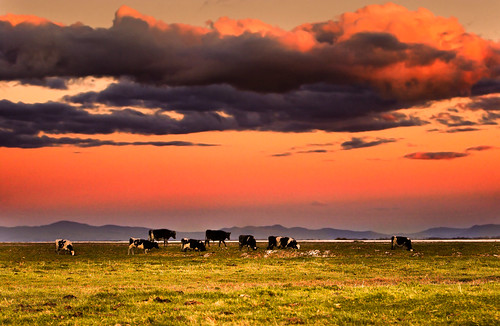
A few weeks ago, before Pixar's newest creation, "Up" began, there was a 10-minute animated film short entitled "Partly Cloudy." This endearing little film artfully re-invented Creationism, in a world where cloud-creatures sculpt the flora and fauna of the earth out of cloud-putty, magically bring them to life, and have them delivered via trusty, devoted storks. Among these clouds was a gray, isolated, petulant fellow who was responsible for creating all the thorny, smelly, violent, dangerous creatures of the world (think porcupines, electric eels, skunks, sharks, rhinos, etc). The stork that worked for this cloud-God was weary, beat-up, and frustrated with the (painful) job at hand. But like most endentured servants, there weren't any alternatives.
Unfortunately this cute, compartmentalized version of life, where every creature has a specific maker, is awfully close to the the truth when it comes to the industrial food system's way of "producing" life. It's just much, much uglier. Creating life, such as cows, pigs, chickens, soybeans, fish, etc, in dark, isolated factories, churning out dangerous animals (E. Coli, pollution, massive energy and water inputs) with abused workers that have no alternatives (deportation) is the norm in our current system.
I was going to commingle a bunch of statistics on how devastating cow "production" and consumption is to the planet, but Dave Tilford of the New American Dream did a great job in his paper "Biodiversity To Go: The Hidden Costs of Beef Consumption" Here's an excerpt:
Despite a certain docile charm, all those cows weigh heavily on the planet. The environmental problems associated with beef production are many and varied, but can be grouped under a common heading: inefficient use of resources. Simply put, the resources necessary to make a cow could be put to better use by some of the planet’s other inhabitants, humans included. Robert Goodland, Senior Environmental Advisor to the World Bank and author of several books on ecological economics, offered this blunt assessment:
Cattle have arguably caused or are related to the most environmental damage to the globe of any non-human species (e.g. overgrazing, soil erosion, desertification, tropical deforestation for ranches).1
Cows are conspicuous consumers of water, food and space. Beckett and Oltjen (1993) estimate that 108 gallons of water is funneled into each quarter pound of beef, counting what the animal drinks and what goes into its feed. (Other estimates range much higher. Ryan and Durning (1995): 616 gallons; Pimental et al (1997): 3000 gallons.) Meanwhile, range cattle in the Western U.S. trample and pollute sensitive riparian areas, while feedlots are responsible for fouling groundwater drinking sources.
In Central and South America, where millions of acres of rainforest have been cleared to make way for pastureland, the effect on global biodiversity has been disastrous:
It is estimated that for every quarter pound hamburger that comes from a steer raised in Central and South America, it is necessary to destroy approximately 75 kilograms (165 pounds) of living matter, “including some of twenty to thirty different plant species, perhaps one hundred insect species, and dozens of bird, mammal, and reptile species.”
Cattle also represent a huge drain on the world’s grain supply. For cattle raised in feedlots, it takes roughly seven pounds of grain to add a pound of live weight to the animal.4 USDA statistics tell us that 70% of the grain produced in the U.S. and 40% of the world's supply is fed to livestock—primarily cattle. Channeled directly to humans rather than diverted to cattle, this grain would represent a huge surplus. Even if the goal is protein production, land use efficiency dictates farming for humans rather than farming for cows. One acre of cereals can produce twice to ten times as much protein as an acre devoted to beef production; one acre of legumes ten to twenty times as much.5 According to the Worldwatch Institute, “Perhaps the greatest potential for increasing food use efficiency lies in reducing consumption of meat, a grain intensive food...[R]educing consumption of [livestock], especially beef, could free up massive quantities of grain and reduce pressure on land.”
Scary stuff. My goal, really, is just to get people to think about these implications for a millisecond when they order that Big Mac. Because after enough milliseconds, it becomes a thought. And thoughts lead to actions. Or at least I hope. Otherwise, the stork is going on strike, and that's a big problem for everyone.
No comments:
Post a Comment